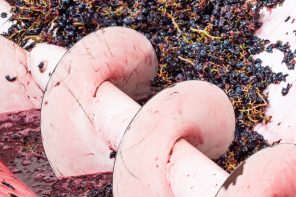Come springtime, rosé lovers around the world rejoice. That faithfully pink drink, it is said, is finally “in season” once winter is dead and Americans are embraced by sunshine and temperatures in the 60’s. We’ve already taken great pains to tell you why you should be drinking rosé all year, but can’t deny that spring and rosé have a special bond, and these are the reasons why:
All the pretty colors!
One of the reasons we all love spring is because it is so damn pretty. Even New York City is beautiful in springtime. This is due solely to the return of the flora that make us fauna so happy. During spring, tourists flock to Greenwich Village to see the bright, deep cherry blossoms bathe the streets in pink. Droves also flock to rosé to bathe their palates in the wonderful pink wine that fits the bright, colorful vibes of their surroundings.
Serving temperature
Everyone knows that winter’s too cold, and many believe that summer’s too hot. Spring is universally loved because it strikes a perfect balance between high heat and bone-chilling cold. Rosé is the same way. White wines should be served at around 50 degrees, but (because they display “red wine flavors” that aren’t as friendly to chilling) rosés are best slightly warmer, think 60-65 degrees. That’s the same temp as your average day in late April or May. Coincidence, we think not?
Alcohol Content
You’d be hard pressed to find a rosé that weighs in at over 13.5% alcohol by volume. The fact that rosé tends to be on the less boozy side has to do with the way it is produced, and this happens to be a very convenient truth for spring drinkers. Summery whites like Vouvray, Muscadet, Riesling or Vinho Verde rarely break the 12% ABV mark, which is too skimpy for some. As always, rosé strikes the perfect balance: it ain’t so strong that it’ll knock you out a sunny day, but it won’t leave you wanting either.
They’re in-betweeners!
No, we don’t mean the seminal, coming-of-age television series popular in the UK. What spring and rosé share is a similar status, that of the in-betweener. Most of us view spring as a bridge between winter and summer, the two boldest and longest seasons. Similarly, rosé is often described as what you get when you make a wine that’s “in between” a red wine and a white wine.
Rosé is exposed to the grape skins, soaks up some of the tannins, coloring and flavors of a red wine, but maintains just as many characteristics typical of a white. Likewise, spring mostly stays cool, keeps winter just in the rearview but embodies most of what we love about summer too. If rosé were a season (some might argue it is) then it would most definitely be spring.
Turf –> Surf
Winter is a season devoted to hearty, big-bodied, boozy red wines and the sorts of dishes that go with ’em: red meat, turkeys, hams, rich flavors and hot carbohydrates as far as the eye can see. Once the weather turns , fresh produce begins to fill the aisles of our local shops, the sea begins to share its bounty and consumers can turn to a fresher, lighter and markedly different set of flavors. As we transition from steaks to fish, fresh salads and recently harvested fruits those “in between” flavors that rosé offer make everything the perfect pairing.
Celebration time!
Your average Tom, Dick or Harry is a lot happier during the prime of spring than in the doldrums of February or the crushing heat of August. Once flowers start blooming, birds start chirping and vacation-takers get planning, it becomes celebration time. One of the best things about rosé is that it is perfect for any celebration. Why? Because it also comes in sparkling form.
A little pink bubbly is the perfect partner for all of the partying that spring ushers in. If you’re still not convinced, give rosé bubbly a try, you won’t be disappointed.








